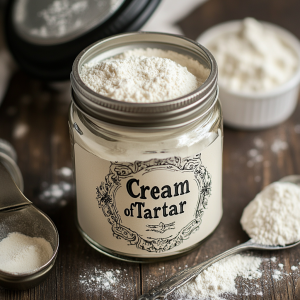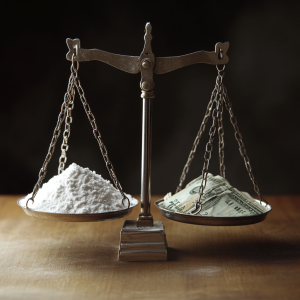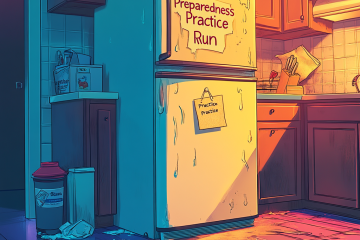
Cream of Tartar has plenty of prepping uses!
Cream of Tartar as a Prepping Supply?
When you think of essential prepping supplies, what comes to mind? Water purification tablets? Emergency rations? While these are undoubtedly crucial, there’s an unsung hero lurking in the shadows of your pantry that deserves the spotlight: cream of tartar. This humble powder, often relegated to the back of spice racks, is a prepper’s secret weapon that can revolutionize your emergency preparedness game.
Imagine a single ingredient that can elevate your baking, boost your cleaning routine, and even serve as a potential home remedy – all while boasting an indefinite shelf life. That’s the power of cream of tartar. As a seasoned prepper who’s weathered my fair share of challenges, I never underestimate the value of versatility. That’s why I always keep a hefty 5-pound container of cream of tartar in my supplies, and I’m about to show you why you should too.
From crafting the perfect emergency biscuits to trading for essential goods in a crisis, cream of tartar’s applications are as diverse as they are surprising. So, buckle up, fellow preppers – we’re about to dive into the extraordinary world of this ordinary-looking powder and discover why it might just become your new favorite multitool in the prepper’s arsenal.
What is Cream of Tartar?
Before we dive into its myriad uses, let’s take a moment to understand what cream of tartar actually is. Despite its name, cream of tartar has nothing to do with cream or tar. It’s actually a byproduct of wine making, scientifically known as potassium bitartrate. During the fermentation process, tartaric acid naturally present in grapes forms crystals in the wine barrels. These crystals are then collected, purified, and ground into the fine, white powder we know as cream of tartar.
What makes cream of tartar particularly useful is its acidic nature. It’s a dry acid, which means it only becomes active when it comes into contact with liquid. This property is what gives cream of tartar its versatility in cooking, baking, and even cleaning. Its acidity allows it to interact with other ingredients in fascinating ways, from stabilizing egg whites to preventing sugar crystallization.
Cream of Tartar to Make Baking Powder
Now that we understand its origins and basic properties let’s explore the many ways cream of tartar can be a game-changer in your prepper’s pantry. Let’s start with one of its star roles: making homemade baking powder. This is a game-changer for any prepper looking to maintain some normalcy in their baking routine during long-term emergencies. The process is simple: mix two parts cream of tartar with one part baking soda. Store this mixture in an airtight container, and you’ve got single-acting baking powder ready to go. For a double-acting version, just add one part of cornstarch to the mix. Use this homemade version as a 1:1 substitute in any recipe calling for baking powder. The best part? Your homemade version is aluminum-free, unlike many commercial varieties. This means no metallic aftertaste in your baked goods and one less unnecessary additive in your diet.
But cream of tartar isn’t just about making things rise – it’s a secret weapon for improving texture across a range of baked goods. In cakes, it helps

Cream of tartar is a great leavening agent
create a finer crumb structure, resulting in a more tender texture. For cookies, especially snickerdoodles, it provides that characteristic tangy flavor and chewy texture. In bread making, a pinch can help strengthen the gluten network, potentially improving the texture and volume of your loaf. When making meringues or whipping egg whites, it stabilizes the foam, allowing for higher, more stable peaks. Whether you’re baking a cake, brownies, or a loaf of bread, a small amount of cream of tartar can make a noticeable difference in the final product’s texture and overall quality.
Substitutes for Cream of Tartar
Now, you might be wondering what to do if you find yourself without cream of tartar. Don’t worry – there are substitutes, though having the real thing on hand gives you more flexibility and consistent results. For stabilizing egg whites, you can use an equal amount of white vinegar or lemon juice. If a recipe calls for cream of tartar in combination with baking soda for leavening, you can replace each 1/2 teaspoon of cream of tartar (plus 1/4 teaspoon of baking soda) with 1 teaspoon of baking powder. And for preventing sugar crystallization in syrups or candies, a few drops of lemon juice or a pinch of citric acid can do the trick.
Cream of Tartar for Food Preservation
Beyond baking, cream of tartar has a surprising role in food preservation. It’s a natural preservative that can help extend the shelf life of homemade jams and jellies. When making your preserves, add 1/8 teaspoon of cream of tartar per cup of sugar before boiling. This small addition helps prevent sugar crystallization and can improve the texture and shelf-life of your jams. In a situation where you’re relying on foraged berries or rationed fruit, this could be crucial for making your precious preserves last longer.
But wait, there’s more! Ha! Cream of tartar isn’t just for the kitchen. It’s a surprisingly effective cleaning agent, especially when it comes to tackling tough stains on metal surfaces. Mix it with a little lemon juice or vinegar, and you’ve got a powerful, natural cleaner for everything from tarnished silver to rusty tools. In a long-term survival situation, maintaining your gear could be crucial, and cream of tartar could help you do just that without relying on harsh chemicals.
Cream of Tartar for Medical Uses
For the medically-minded prepper, cream of tartar has some interesting potential uses. While it’s always best to consult with a medical professional, some people use cream of tartar as a natural remedy for urinary tract infections or to help quit smoking. For UTIs, the folk remedy involves mixing 1.5 teaspoons of cream of tartar in a cup of warm water with a few drops of lemon juice, drinking this solution once or twice a day. The high potassium content is believed to create an inhospitable environment for bacteria. For those looking to quit smoking, some people mix 1/2 teaspoon of cream of tartar with a glass of orange juice, drinking this nightly for 30 days. The belief is that it helps flush nicotine from the body, though scientific evidence for this is limited. It’s also been traditionally used to help relieve the pain of arthritis. In a scenario where traditional medical care might be limited, having knowledge of these potential uses could be valuable.
Cream of Tartar for Barter
Perhaps one of the most overlooked benefits of cream of tartar for preppers is its potential as a bartering item. In a post-disaster economy, this

Cream of tartar can be used as a barter item
versatile powder could be worth its weight in gold to those who understand its many uses. It’s lightweight, compact, and has that all-important infinite shelf life – making it an ideal trade good.
So, fellow preppers, next time you’re taking inventory of your survival supplies, don’t forget to stock up on cream of tartar. This unassuming powder might just be the secret weapon that sees you through tough times with cleaner gear, fluffier eggs, tastier baked goods, and maybe even a slice of cake to lift your spirits. In the unpredictable world of emergency preparedness, versatility is key – and cream of tartar delivers that in spades. Remember, a 5-pound container, like the one I always keep on hand, could be a game-changer in your prepping strategy. With its myriad uses and indefinite shelf life, cream of tartar truly earns its place as the unsung hero of the prepper’s pantry.


